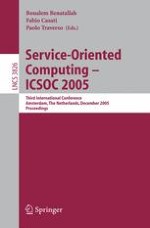This volume contains the proceedings of the Third International Conference on Service-Oriented Computing (ICSOC 2005), that took place in Amsterdam, The Netherlands, December 12-15, 2005. The 2005 edition had the important and ambitious goal of bringing together the different communities working in Web services and service-oriented computing. By attracting excellent contributions from different scientific communities, ICSOC aims at creating a scientific venue where participants can share ideas and compare their approaches to tackling the many still-open common research challenges. The commitment to cross-area fertilization was put into practice by having a very diversified Program Committee and by the presence of several area coordinators, leaders in the respective communities who encouraged and supervised submissions in each area. This is also the first edition to feature a successful workshop and demo program, with selected demos also presented in a paper-like fashion so that they get the attention they deserve. In addition, ICSOC 2005 inherited from previous editions a strong industrial presence, both in the conference organization and in the program. This is very important due to the industrial relevance and the many challenges of service oriented technologies.
